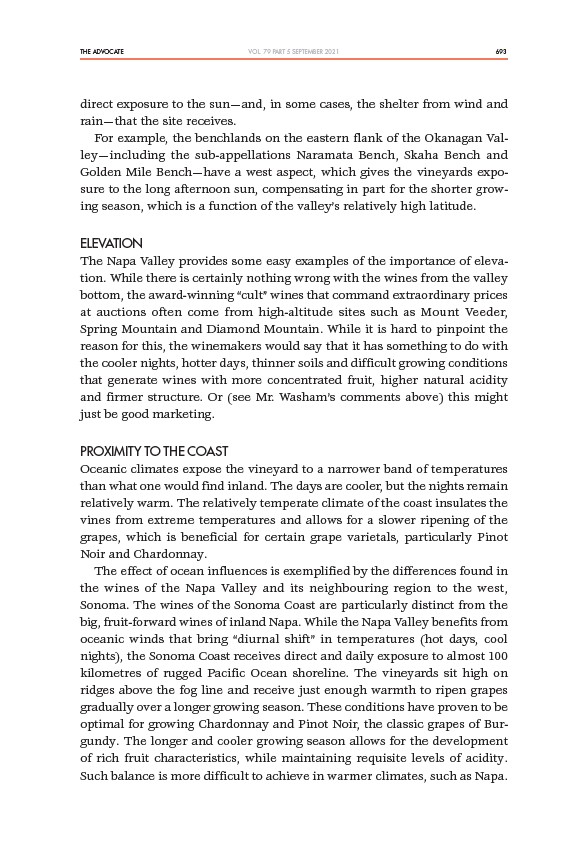
THE ADVOCATE 693
VOL. 79 PART 5 SEPTEMBER 2021
direct exposure to the sun—and, in some cases, the shelter from wind and
rain—that the site receives.
For example, the benchlands on the eastern flank of the Okanagan Valley—
including the sub-appellations Naramata Bench, Skaha Bench and
Golden Mile Bench—have a west aspect, which gives the vineyards exposure
to the long afternoon sun, compensating in part for the shorter growing
season, which is a function of the valley’s relatively high latitude.
ELEVATION
The Napa Valley provides some easy examples of the importance of elevation.
While there is certainly nothing wrong with the wines from the valley
bottom, the award-winning “cult” wines that command extraordinary prices
at auctions often come from high-altitude sites such as Mount Veeder,
Spring Mountain and Diamond Mountain. While it is hard to pinpoint the
reason for this, the winemakers would say that it has something to do with
the cooler nights, hotter days, thinner soils and difficult growing conditions
that generate wines with more concentrated fruit, higher natural acidity
and firmer structure. Or (see Mr. Washam’s comments above) this might
just be good marketing.
PROXIMITY TO THE COAST
Oceanic climates expose the vineyard to a narrower band of temperatures
than what one would find inland. The days are cooler, but the nights remain
relatively warm. The relatively temperate climate of the coast insulates the
vines from extreme temperatures and allows for a slower ripening of the
grapes, which is beneficial for certain grape varietals, particularly Pinot
Noir and Chardonnay.
The effect of ocean influences is exemplified by the differences found in
the wines of the Napa Valley and its neighbouring region to the west,
Sonoma. The wines of the Sonoma Coast are particularly distinct from the
big, fruit-forward wines of inland Napa. While the Napa Valley benefits from
oceanic winds that bring “diurnal shift” in temperatures (hot days, cool
nights), the Sonoma Coast receives direct and daily exposure to almost 100
kilometres of rugged Pacific Ocean shoreline. The vineyards sit high on
ridges above the fog line and receive just enough warmth to ripen grapes
gradually over a longer growing season. These conditions have proven to be
optimal for growing Chardonnay and Pinot Noir, the classic grapes of Burgundy.
The longer and cooler growing season allows for the development
of rich fruit characteristics, while maintaining requisite levels of acidity.
Such balance is more difficult to achieve in warmer climates, such as Napa.